Take me back to the list of lessons
The chess pieces
Here’s how the chess pieces look when they’re lined up on the chess board. Let’s meet each of them in turn!
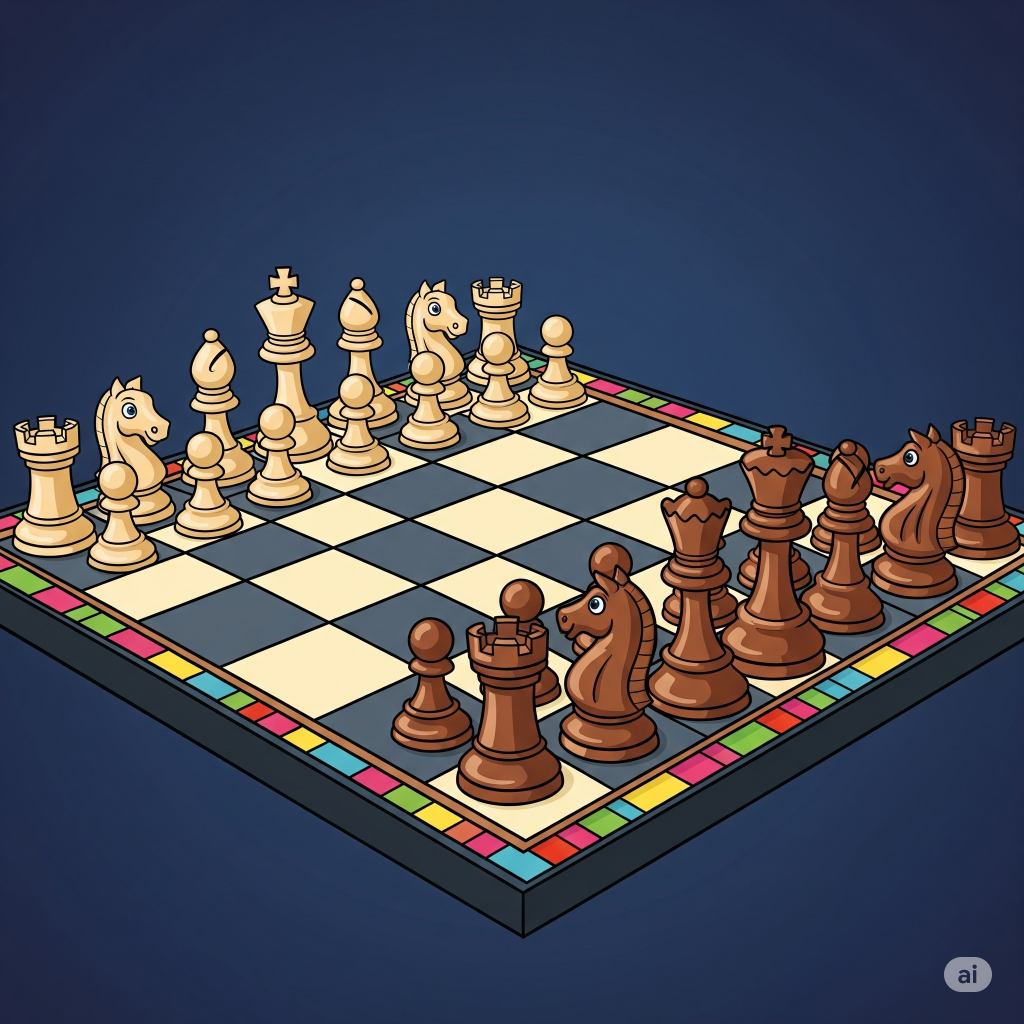
The King ♔
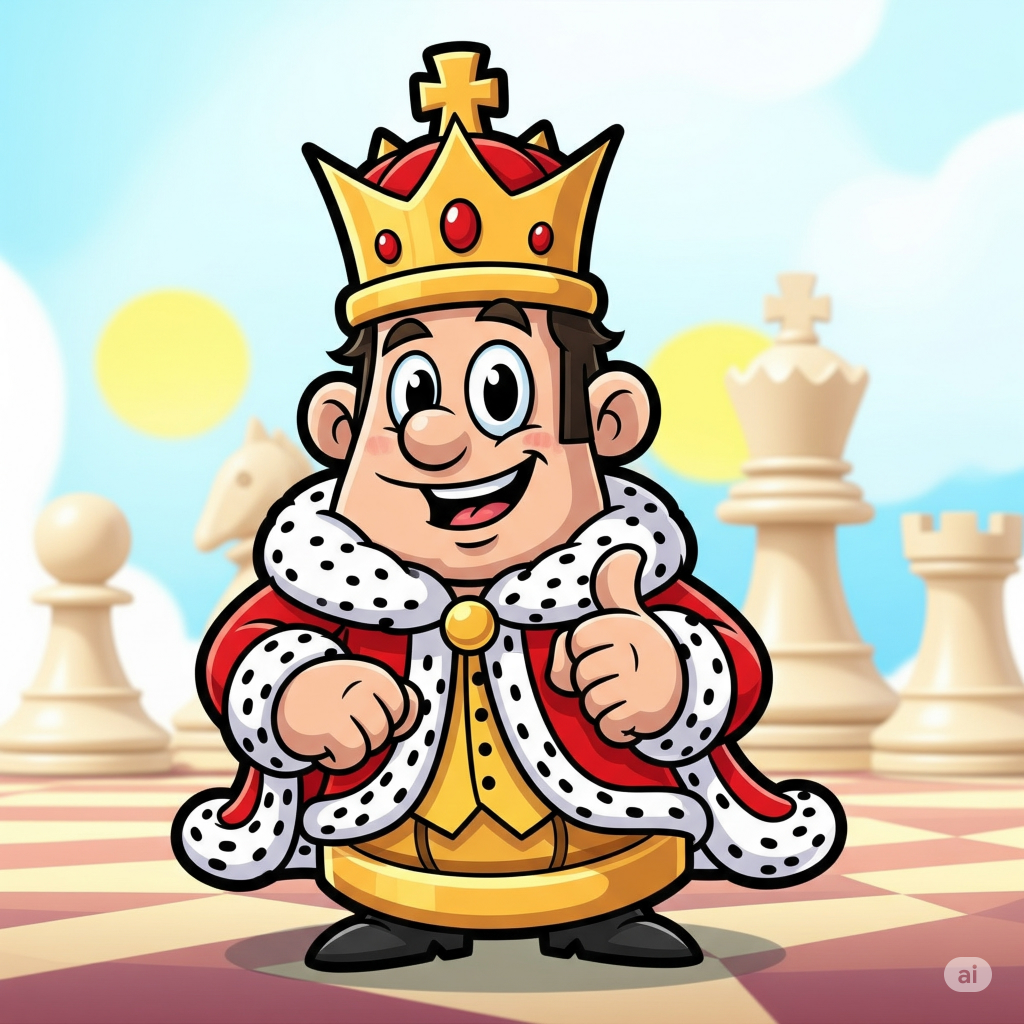
The King is the most important piece on the board, but also the most vulnerable! He’s like the pampered royal who everyone else has to protect. He can only move one square at a time in any direction, making him a bit slow and clumsy, but if he falls, the game is over! Keep him safe, or it’s checkmate!
How the King Moves (One Tiny Step at a Time!)
Imagine the King is a little bit shy, or maybe just very careful!
- He can only move one step at a time.
- But here’s the cool part: He can step in any direction he wants!
- He can move forward (like taking a tiny step closer to adventure!).
- He can move backward (like taking a tiny step to hide!).
- He can move sideways (left or right, like shuffling along!).
- And he can even move diagonally (like taking a tiny step at an angle!).
So, from any square, he can reach up to 8 other squares, as long as they’re just one tiny step away! He’s always on his tiptoes, ready to make a little wiggle move.
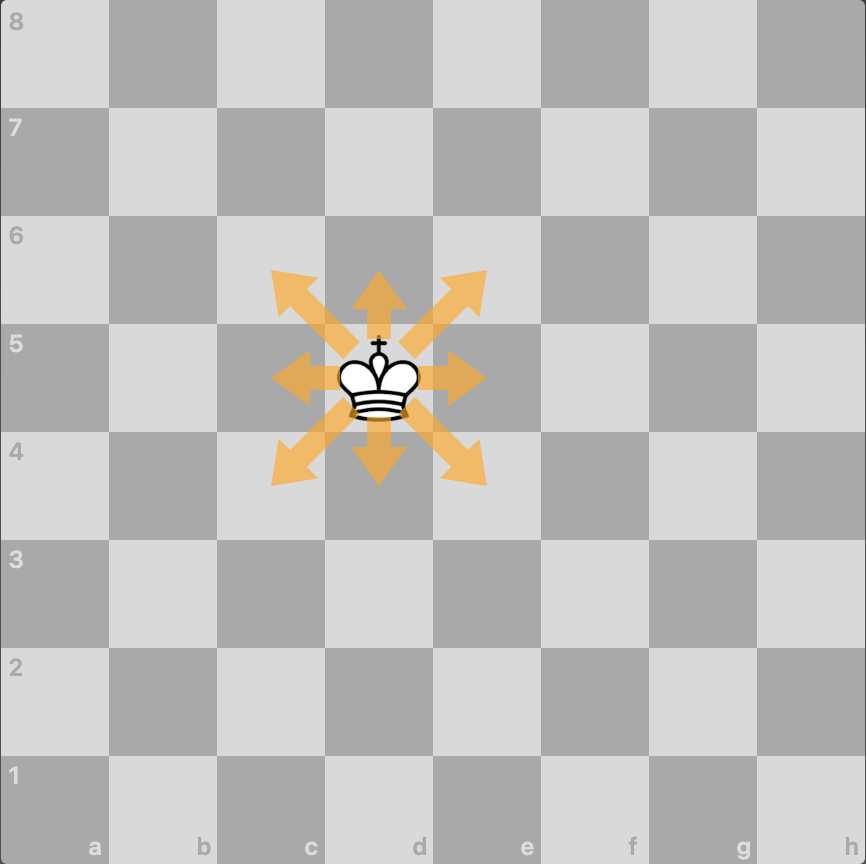
But note the King can only move to one of these square if it is a safe square – if a square is under attack from an opponent’s piece he cannot move there; we’ll see more on this later).
The King’s Special Features (He’s Super Important!)
The King might be a slow mover, but he has the most important job and a super special rule:
He Can Never Be Captured! (The “Checkmate” Rule!)
- This is the BIGGEST rule about the King! He can never be taken off the board. If an enemy piece is attacking him (we call this being in “check“, he must get out of danger right away!
- He can:
- Move to a safe square.
- Block the attack with another one of your pieces (like a shield!).
- Capture the piece that’s checking him.
The diagram below shows a king which is in check from an opposition bishop, and the safe (green) squares he can move to to get out of check and the unsafe (red) squares he is not allowed to move to.

If he can’t do any of those things, and he’s stuck in “check” with nowhere to go, then it’s “Checkmate!” That means the game is over, and the player whose King is checkmated loses. So, protecting your King is the most important job in chess!
The diagram below shows a king which is in check from two opposition bishops and a rook, and there are no safe (green) squares to move to. This is checkmate and the safe (green) squares he can move to to get out of check and the unsafe (red) squares he is not allowed to move to.
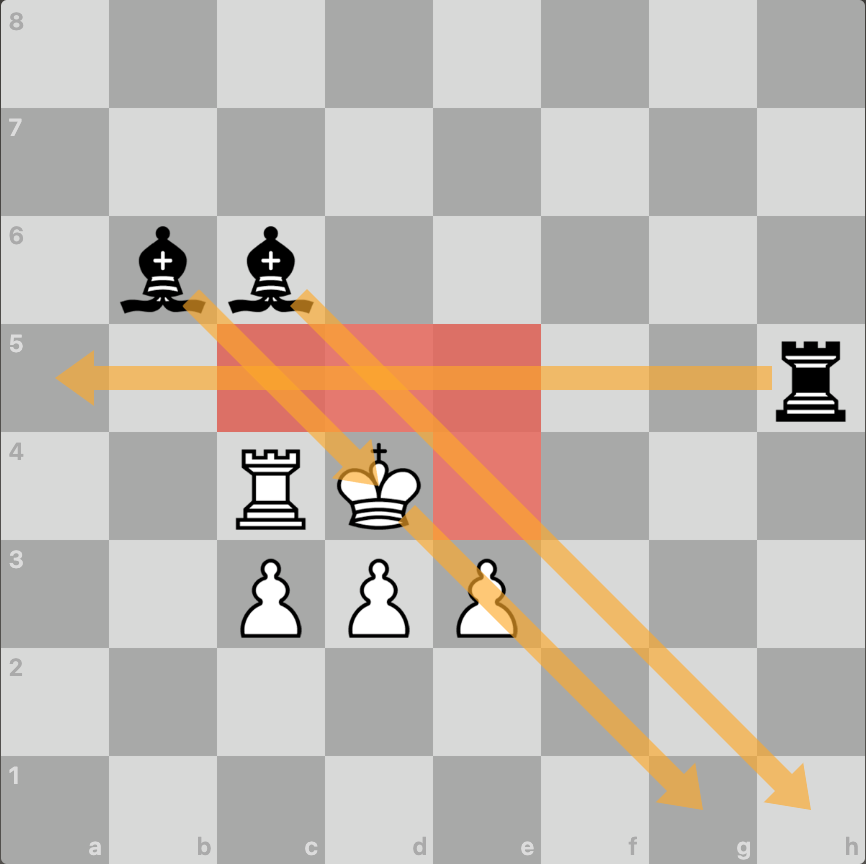
- Castling! (The King’s Big Hop!)
- This is the King’s only “super special” move! It’s like he gets to do a magical escape trick!
- What it is: Castling involves the King and one of your Rooks (the castle pieces) moving at the same time. The King hops two squares towards a Rook, and then that Rook jumps over the King and lands right next to him on the other side!
- Why it’s cool: It gets your King to safety (usually behind some pawns) and brings your Rook into the game faster.
- When can he do it? Only if:
- Neither the King nor that Rook has moved yet in the game.
- There are no pieces between the King and that Rook.
- The King isn’t currently in check, and he won’t move through or into a square that’s being attacked by an enemy piece.
So, while the King might seem a bit slow, he’s the heart of your army, and keeping him safe is what the whole game is about! He’s the main character in your chess adventure!
The Queen ♕
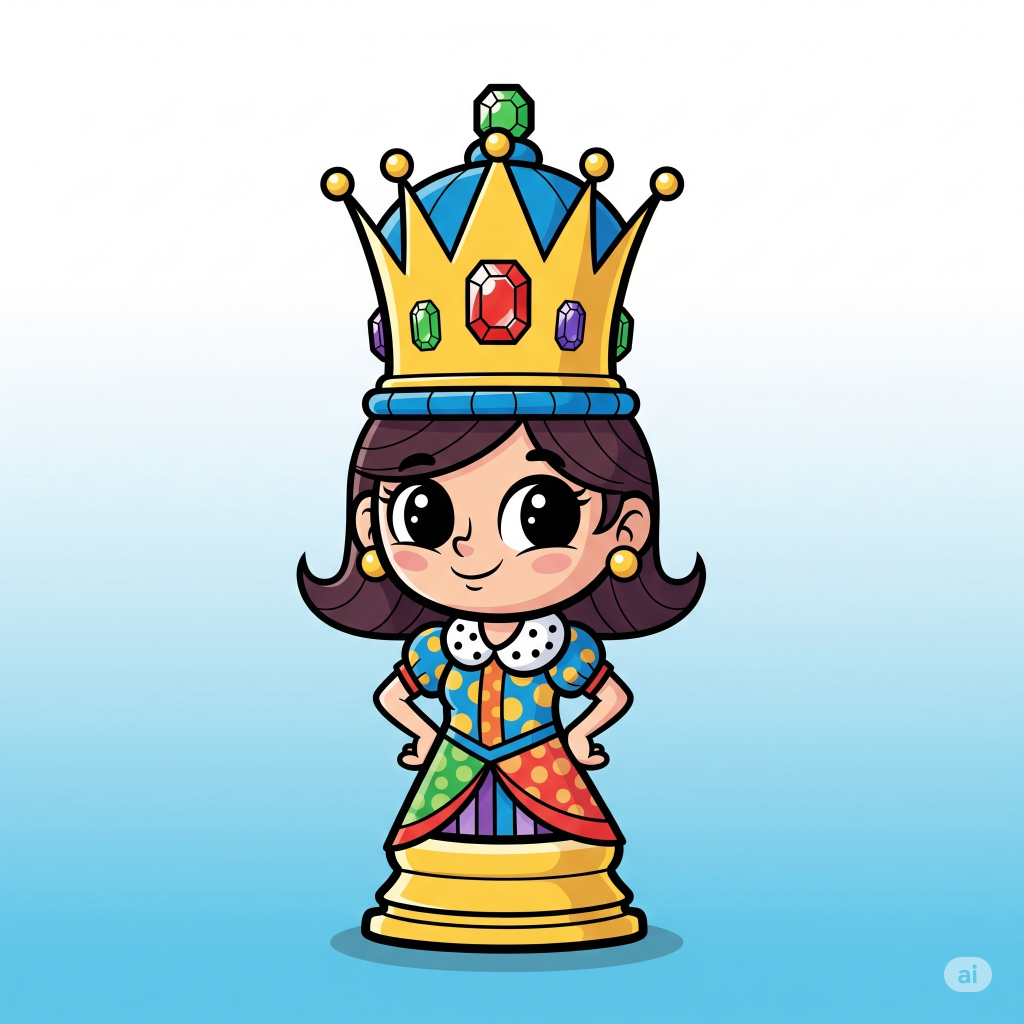
The Queen is the ultimate power player on the chessboard! She’s fast, fierce, and can move any number of squares in any direction—horizontally, vertically, or diagonally. Think of her as the athletic, multi-talented superstar who can dominate the entire board. She’s your best attacker, so use her wisely!
Alright, gather ’round, chess adventurers, and let me tell you about the most amazing, super-powered piece on the whole chessboard: The Queen!
Imagine the Queen as a majestic, shimmering superhero with the coolest cape and the most incredible abilities. She’s not just any ordinary royal; she’s like having a robot that can do EVERYTHING in one!
How Does She Move?
The Queen is a combination of TWO other strong chess pieces:
- She’s like a Super-Rook!
- Think of a Rook as a straight-line rocket. It can blast off in any straight line:
- Forward (like a car going straight down a road)
- Backward (like a car backing up)
- Sideways to the left
- Sideways to the right
- The Queen can do all of this, and she can go as many squares as she wants in that straight line, as long as nothing is blocking her way! Vroom! She’s super fast!
- Think of a Rook as a straight-line rocket. It can blast off in any straight line:
- She’s also like a Super-Bishop!
- Now, imagine a Bishop as a diagonal zig-zag master. It loves to glide along the slanted lines of the chessboard:
- Diagonally forward to the left
- Diagonally forward to the right
- Diagonally backward to the left
- Diagonally backward to the right
- Guess what? The Queen can do this too! She can glide as many squares as she wants along those diagonal lines, as long as her path is clear. Whoosh! She’s incredibly graceful!
- Now, imagine a Bishop as a diagonal zig-zag master. It loves to glide along the slanted lines of the chessboard:
So, put it all together: The Queen can move in ANY straight line – up, down, left, right, or diagonally – and she can go as far as she wants until she hits something or captures an enemy! She’s like having a personal teleportation device that only works in straight lines!
Unique Characteristics (What makes her so special and fun!):
- The Ultimate Powerhouse: She is the strongest piece on the entire board! Seriously, no other piece has as many amazing moves as she does. If you put her in the middle of the board, she can see and reach more squares than anyone else – sometimes up to 27 squares in one turn! That’s like being able to visit almost half the city in a single hop!
- A Capturing Queen! Just like all the other pieces, if the Queen lands on a square where an enemy piece is chilling, she gets to capture it! Poof! The enemy piece is gone, and your Queen takes its spot.
- She Can’t Jump! Even though she’s super powerful, there’s one thing the Queen can’t do: she can’t jump over other pieces! If one of your own pieces or an enemy piece is in her way, she has to stop right before it (unless she captures the enemy piece). Think of it like a superhero flying, but if there’s a big building in the way, she has to go around it, not through it!
- The King’s Best Friend: The Queen’s main job is to help protect her King and attack the enemy King. She’s like the King’s most loyal and fierce bodyguard, always ready to jump into action!
- Born on Her Own Color! Here’s a cool little secret: When you set up the board, the White Queen always starts on a white square, and the Black Queen always starts on a black square. It’s like she always matches her outfit to her starting spot!
So, when you’re playing chess, remember the Queen is your most versatile and powerful friend. Use her wisely, and she’ll help you win the day! Just make sure you don’t let her get caught!
The Rook ♖

The Rooks are like mighty castles on wheels! They’re strong, steady, and can move any number of squares horizontally or vertically. They love open lines and are fantastic for controlling long stretches of the board. Plus, they get to do a special move with the King called castling to keep him safe!
Alright, young chess champions, let’s dive into the world of another amazing chess piece: The Rook!
Imagine the Rook as a mighty castle tower that’s been given legs and a super engine! Sometimes people call it a “castle” because it looks just like one, tall and strong. But this isn’t just any old castle; it’s a fast-moving fortress on the battlefield!
How Does It Move?
The Rook loves straight lines, like a super-fast train on a track or a car driving perfectly straight down a road. It can zoom in four directions, and only four directions:
- Forward: It can blast off straight ahead, moving as many squares as it wants. Vroom!
- Backward: It can zip straight backward, again, as far as it wants. Screech!
- Sideways to the Left: It can slide perfectly to its left, covering any number of squares. Swish!
- Sideways to the Right: And finally, it can glide perfectly to its right, as far as it needs to go. Zoom!
Think of the Rook as being stuck on a giant grid of invisible lines. It can only travel along the lines that go straight up and down, or straight side to side. It loves to travel in straight lines, like a ruler drawing a perfectly straight path!
So, the Rook moves in straight lines – up, down, left, or right – and it can go as many squares as it wants, as long as its path is clear!
Unique Characteristics (What makes this castle-on-wheels so special and fun!):
- The Straight-Line Superstar: The Rook is the absolute best at moving in straight lines. No other piece can cover so much ground so quickly in just one straight direction. This makes it super powerful when you want to clear a path or control a long row or column on the board!
- No Diagonal Moves! This is very important: the Rook NEVER, EVER moves diagonally. It’s like it has a rule: “Only straight paths for me, thank you very much!” If you see a Rook trying to move at a slant, tell it, “Whoa there, Rook, you’re going the wrong way!”
- It Can’t Jump! Just like the Queen (and most other pieces), the Rook is strong, but it can’t magically jump over other pieces, whether they’re your own or the enemy’s. If there’s another piece in its straight-line path, it has to stop right before it.
- Capturing: If that piece in its way is an enemy, the Rook can zoom up to that square, take the enemy piece off the board, and then happily sit in its new spot!
- The “Castle” of the Corners: At the very start of the game, you’ll find your Rooks tucked away in the four corners of the chessboard. They’re like loyal guardians, waiting to unleash their straight-line power!
- The Special “Castling” Move! This is super cool and super unique! The Rook has a special partnership move with the King called “Castling.” It’s the only time two of your own pieces can move at the same time in one turn!
- Imagine the King is feeling a bit exposed in the middle of the board. If the path between the King and one of your Rooks is completely clear, and neither has moved yet, they can do a special “safety dance.”
- The King moves two squares towards the Rook, and then the Rook jumps over the King and lands right next to him on the other side! It’s like the King quickly hides inside his castle for protection.
- This is the only time a Rook can “jump” over another piece (and it’s only the King, and only during Castling!). It’s a fantastic way to keep your King safe and bring your Rook into the action!
So, remember the Rook is your powerful straight-line specialist, ready to control big sections of the board and even help your King find safety with a special move! Use your Rooks wisely, and they’ll be key to your chess victories!
The Bishop ♗

The Bishops are the sneaky snipers of the chessboard! They move any number of squares diagonally, always staying on the same color square they started on. They’re great at attacking from a distance and can slice through enemy lines with precision. Each Bishop covers a different color, so they make a great pair!
Alright, future Grandmasters, let’s meet another super cool chess piece: The Bishop!
Imagine the Bishop as a magical wizard or a secret agent who only travels on diagonal paths! He’s not interested in going straight like the Rook or everywhere like the Queen. Oh no, the Bishop has his own special way of zipping around the board!
How Does It Move?
The Bishop is a diagonal daredevil! He loves to glide across the chessboard in slanted lines, like skiing down a snowy hill or drawing a perfect diagonal line with a ruler. He can move in all four diagonal directions:
- Diagonally Forward-Right: He can zoom up and to the right, as many squares as he wants! Swoosh!
- Diagonally Forward-Left: He can zip up and to the left, as far as he needs to go! Whoosh!
- Diagonally Backward-Right: He can slide back and to the right, covering any number of squares! Glide!
- Diagonally Backward-Left: And finally, he can glide back and to the left, as far as his path is clear! Slither!
Think of the chessboard like a giant checkerboard with squares of two different colors: light and dark. Each Bishop has a special connection to only one of those colors!
So, the Bishop moves only in diagonal lines, and it can go as many squares as it wants in that diagonal line, as long as its path is clear!
Unique Characteristics (What makes this diagonal dynamo so special and fun!):
- The Color-Bound Cruiser! This is the Bishop’s most amazing and unique superpower! Each Bishop is stuck on one color of squares for the ENTIRE game!
- You start with two Bishops: one on a light square and one on a dark square.
- The Bishop that starts on a white square will always, always stay on white squares as it moves diagonally. It will never touch a black square!
- The Bishop that starts on a black square will always, always stay on black squares as it moves diagonally. It will never touch a white square!
- It’s like they have a magical invisible paint that matches their starting square, and they can only walk on that color! This means they can reach half the squares on the board, but never the other half!
- Long-Range Snipers: Because they can go as far as they want on their diagonals, Bishops are excellent at attacking pieces from a distance! They can be like long-range snipers, aiming across the board to capture an enemy piece far away.
- No Jumping Allowed! Just like most other pieces, the Bishop is powerful but polite – it can’t jump over other pieces, whether they’re your own or the enemy’s. If there’s another piece blocking its diagonal path, it has to stop right before it.
- Capturing: If the piece blocking its way is an enemy, the Bishop can happily land on that square, capture the enemy, and take its place!
- The Dynamic Duo! Even though each Bishop is stuck on one color, having both of your Bishops (one on light squares, one on dark squares) is super strong! Together, they can cover almost every square on the board, working as a fantastic team to attack and defend. They complement each other perfectly!
- Opening Up the Lines: Bishops love it when the middle of the board is open. When there are fewer pawns blocking their paths, they can become incredibly powerful, zipping around and causing all sorts of trouble for your opponent!
So, remember the Bishop as your super-cool diagonal wizard, always gliding on its special color, and ready to surprise your opponent with long-range attacks! Use your Bishops wisely, and they’ll help you spot weaknesses far across the board!
The Knight ♘

The Knights are the tricksters of the board with their unique “L-shaped” move. They go two squares in one direction (horizontal or vertical) and then one square perpendicular to that. The best part? They’re the only piece that can jump over other pieces! This makes them excellent for surprising attacks and leaping into action.
Alright, little chess adventurers, get ready to meet the most unique and sneaky piece on the chessboard: The Knight!
Imagine the Knight as a bouncy, spring-loaded horse that’s a master of jumping and surprising its opponents! Unlike all the other pieces that move in straight lines or diagonals, the Knight has its very own special “L-shaped” jump.
How Does It Move?
The Knight moves in a very peculiar and cool way, like drawing a letter ‘L’ or a number ‘7’ or ‘Γ’ on the board! It’s a two-part move:
- Two Steps in One Direction: First, the Knight takes two steps in a straight line – either straight forward, straight backward, straight to the left, or straight to the right.
- One Step to the Side: Then, without stopping, it takes one step to the side (left or right) to complete its “L” shape.
Let’s break it down, like a little jump dance:
- Imagine the Knight is standing on a square.
- It takes 2 steps forward, then 1 step to the side (left or right).
- Or, it takes 2 steps backward, then 1 step to the side (left or right).
- Or, it takes 2 steps to the left, then 1 step up or down.
- Or, it takes 2 steps to the right, then 1 step up or down.
It’s like hopping over two squares, and then immediately making a sharp turn!
The Knight always lands on a square that is a different color from the square it started on! If it starts on a white square, it will always land on a black square, and vice versa. It’s like a magical color-changer with every jump!
Unique Characteristics (What makes this jumping horse so special and fun!):
- The ONLY Jumper! This is the Knight’s coolest superpower: it’s the only piece on the entire chessboard that can jump over other pieces!
- Imagine a busy street. A Rook or a Queen would get stuck if a car was in the way. But the Knight? Boing! It just hops right over any pieces (friendly or enemy) that are blocking its path to its landing square. It’s like having a super jump ability that lets it ignore traffic!
- It doesn’t capture the pieces it jumps over, it just flies right above them. It only captures if its landing square is occupied by an enemy piece.
- The Sneaky Attacker: Because it can jump over pieces, the Knight is fantastic at launching surprise attacks! It can jump into places that other pieces can’t reach directly, like surprising a King hiding behind its Pawns. It’s like a ninja that can get behind enemy lines!
- The “Fork” Master! The Knight is famous for a special trick called a “fork.” Because of its L-shaped move, it can often land on a square where it’s attacking two different enemy pieces at the same time! This makes the opponent have to choose which piece to save, and usually, you get to capture the other one. It’s like having two laser pointers aiming at different targets at once!
- Starts in the Corners (Almost)! At the beginning of the game, your Knights stand right next to your Rooks, waiting to leap into action. They’re usually one of the first pieces to get moving!
- A “Hopper” Not a “Glider”: Unlike the Queen, Rook, or Bishop which glide across many squares, the Knight always moves to a square exactly “L” shape away. It doesn’t move a little bit on an L, it always completes the full “L” hop.
So, remember the Knight is your amazing jumping horse, ready to surprise opponents, leap over obstacles, and become a master of sneaky attacks! When you want to get into a tight spot or hit multiple targets, the Knight is your go-to friend!
The Pawn ♙
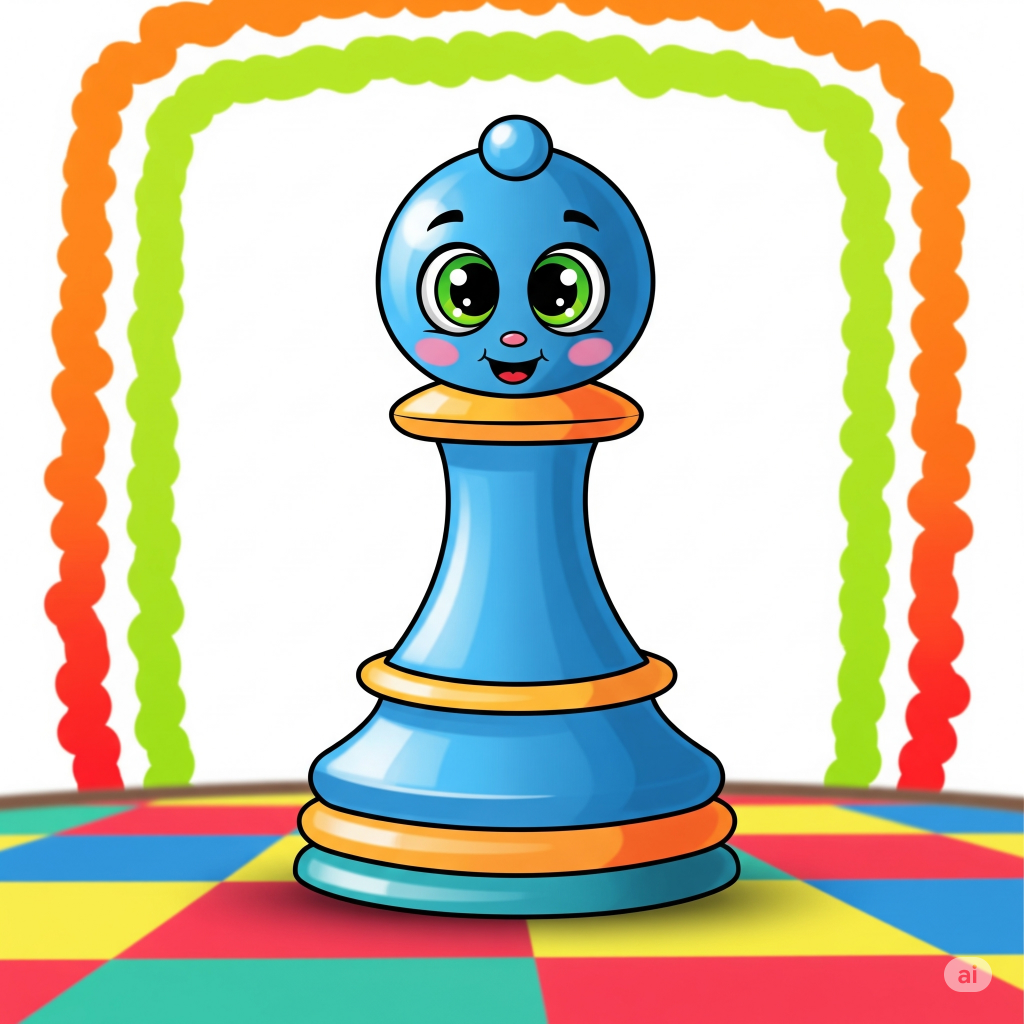
Pawns are the little soldiers of the chessboard, and there are eight of them! They’re usually the first to charge into battle, moving one square forward (though they can move two on their very first move). They’re the only piece that captures diagonally, and if a Pawn makes it all the way to the other side of the board, it gets promoted into a more powerful piece—usually a Queen! Talk about a glow-up!
Alright, little chess cadets, get ready to meet the most numerous and surprisingly heroic piece on the chessboard: The Pawn!
Imagine the Pawns as your brave little foot soldiers, marching bravely into battle! There are more of them than any other piece, and even though they seem small, they have some really special tricks up their sleeves!
How Does It Move?
The Pawn is a bit different from the other pieces because it moves mostly in one direction and has a special way of capturing!
- Strictly Forward: Pawns are like little marching robots – they only move straight forward! They can’t move backward, sideways, or diagonally (unless they’re capturing, but we’ll get to that!).
- One Step at a Time: Most of the time, a Pawn moves just one square forward at a time. Step, step, step!
- The Big First Jump! Here’s their first special trick! On their very first move of the game, a Pawn has a choice: it can move one square forward, OR it can take a big leap and move two squares forward! This is like them getting a super boost at the start line. Once they’ve moved, though, they can only move one square forward for the rest of the game.
- Capturing (The Sneaky Diagonal Munch!): This is where Pawns get clever! They don’t capture straight ahead. Instead, a Pawn captures by moving one square diagonally forward!
- Imagine a Pawn walking forward, and suddenly it sees an enemy piece just one square away, either diagonally to its front-left or diagonally to its front-right. Chomp! The Pawn can then move onto that square, gobble up the enemy piece, and take its place!
- If there’s an enemy piece directly in front of a Pawn, the Pawn cannot capture it. It’s like having a wall in front of them – they’re stuck until that square is clear, or they find something to capture diagonally!
Unique Characteristics (What makes these little soldiers so special and fun!):
- The Marching Army: You start with eight Pawns, more than any other piece! They form a brave line in front of all your bigger pieces, protecting them and pushing forward to gain ground. They’re like the front lines of your chess army!
- No Retreat! No Surrender! Pawns can NEVER move backward! Once they’ve taken a step forward, that’s their path for life. They’re all about forward progress!
- The Promotion Power-Up! This is the most exciting and unique thing about Pawns! Even though they start small, if a Pawn can bravely march all the way across the board and reach the opposite end (the enemy’s back rank), it gets a HUGE reward!
- When a Pawn reaches the very last row, it instantly gets to transform into a more powerful piece! You can choose to change your Pawn into a Queen, a Rook, a Bishop, or a Knight! (Most players pick a Queen because she’s the strongest!).
- It’s like a tiny caterpillar turning into a magnificent butterfly, or a regular soldier getting a superhero upgrade! This is called “Pawn Promotion,” and it’s a game-changer! You can even have two Queens on the board if you promote a Pawn!
- En Passant (The “In Passing” Sneak Attack!): This is a tricky, but super cool, special Pawn move that only happens sometimes!
- Imagine an enemy Pawn uses its “two-square first move” and lands right next to your Pawn, on the same row.
- If your Pawn could have captured that enemy Pawn if it had only moved one square, you get a special chance! On your very next turn only, your Pawn can move diagonally behind the enemy Pawn and capture it, as if the enemy Pawn had only moved one square.
- It’s a bit like a “catch-them-in-the-act” rule! It’s called “En Passant,” which means “in passing” in French. It’s a rare but very satisfying capture!
So, remember your Pawns are your many, brave little soldiers. They move simply, but their ability to capture diagonally, leap two squares on their first move, and especially their chance to become a mighty Queen, make them incredibly important heroes on the chessboard! Never underestimate a Pawn!
Ok, now that we’ve learned a bit about the chess board and the chess pieces, let’s have a look at how they come together on the board in Lesson 3 – Setting up the board and chess notation